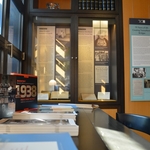Posts from the Past, 80 Years after 1938

- Author
- Dr. Miriam Bistrovic
- Date
- Mon, Jan 1, 2018
In the synagogue on Berlin’s Prinzregentenstrasse, a group of young men were waiting to be confirmed as full members of the Jewish Community. The Bar Mitzvah ceremony is a joyous occasion, but Rabbi Manfred Erich Swarsensky tried to impress this on the fifteen youths that stood before him in an unusual way. “I have no other wish for you,” he said in his sermon, “beyond the hope that, even in your later years, when you look back on the day of your Bar Mitzvah, you will consider yourselves Jews—gladly, with joy and pride—even in a time and place where one is not forced to be a Jew by the external factors of life.” Despite the Rabbi’s warm words for the young men and their families, the mood on that Shabbat in September 1938 was gloomy. Those gathered there knew all too well that they were witnessing the last such ceremony in their community. Nevertheless, Swarsensky reminded his audience of the achievements of earlier generations and the “once so grand and beautiful history of German Jewry,” so that it might be preserved in the memory of succeeding generations. Even he was painfully aware, however, that “it is easier to destroy than to build up.”
In retrospect, his speech, which he wrote down on September 28, 1938, seems almost prophetic. Only two months later, on the night of November 9, the magnificent synagogue was set ablaze by gangs of Nazis. Manfred Swarsensky was arrested and interned in the Sachsenhausen concentration camp, and the Jewish Community was forced to pay for the structural stabilization of the burnt-out shell of the building.
In 1941, they were forced to sell the land to the city far below its actual value. Violence like that of November 9, 1938, which destroyed countless livelihoods within hours, was still unimaginable at the beginning of that year. Despite the many anti-Jewish measures that had been enacted since the Nazis rose to power in 1933, some German-speaking Jews still hoped, even at the beginning of 1938, that such discrimination was part of a temporary phase. They believed that the social position that they had fought so hard to attain over centuries would still protect them. Germany and Austria were their homelands, where they had won their emancipation long before the antisemitic ideology of the National Socialists took hold.
The events of 1938 left no doubt; there would be no going back. They constituted a rupture, the irreversible revocation of any hope for the future, which burned itself into the memory of German Jews and left traces in letters and diaries. A cascade of new legal restrictions increasingly served to eliminate the already severely curtailed ability of Jews to earn a living. In March, the German annexation of Austria extended the restrictions on Jewish freedom to hundreds of thousands of Austrian Jews. Physicians saw their licenses revoked, lawyers were banned from practicing law. An international conference in Evian brought together representatives from 32 nations and numerous relief organizations but offered no practical solutions to the refugee crisis. A new law on name changes served to mark Jews by mandating the assumption of “typically Jewish” names like “Israel” and “Sara.” Passports were declared invalid until they were stamped with a red “J.” In late October, thousands of Polish citizens living in Germany were deported.
All this happened before the pogrom of November 9, 1938, euphemistically referred to as the Kristallnacht. That night, symbols of Jewish life in Germany were destroyed by gangs of vandals putatively motivated by popular anger against the Jews, but who were in fact organized by the state. The targets included synagogues, schools, hospitals, cemeteries, and businesses large and small, but the perpetrators also attacked private homes and individuals. The devastation was so great that even the countries that had thus far refused to take action to help the refugees could no longer close their eyes. Great Britain loosened its immigration restrictions somewhat, allowing thousands of unaccompanied children to immigrate in an unprecedented humanitarian action. Many families saw the “Kindertransport” as the only way to save that which they treasured most, their children. With heavy hearts, desperate parents sent their children abroad to an uncertain future. They saved their children’s lives, and in many cases, never saw them again.
In 2018, we mark the eightieth anniversary of these dramatic events. As a repository for the cultural legacy of German-speaking Jews and a key institution of the German Jewish diaspora, the Leo Baeck Institute – New York | Berlin (LBI) is commemorating these events with the 1938Projekt. A bilingual online calendar, a traveling exhibition, and numerous conferences and public programs are placing individual stories in the foreground to make the past present.
The project is unique in both scope and perspective. The online calendar uses documents from the archives of the LBI and numerous partner institutions to tell 365 individual stories, one for each day of 1938. Every day, the 1938Projekt publishes a new story for the corresponding date in 1938 on its website, Facebook, Twitter, and Instagram. Each document or object reflects the private experiences and perceptions of its creator, thus highlighting the personal fates behind the grim statistics.
LBI has worked to learn from the experiences of the surviving eyewitnesses to these events and to preserve the material record of their experiences. As the generation of the youngest refugees passes away, we will lose a vital connection to the German-Jewish past that makes this kind of memory work all the more crucial. Their letters, diaries, and mementos will be the most immediate way to access this history, and it is these materials that will transmit their cultural legacy to future generations.
Today, as right-wing populism gains new followers internationally, the private thoughts recorded by German Jews in letters and diaries in 1938 take on new meaning. They can tell us much about a minority’s struggle for civil rights and social integration, as well as the tremendous achievements that follow when such struggles are successful. They also offer a warning about the disastrous consequences of discrimination, exclusion, and persecution.
Latest News





